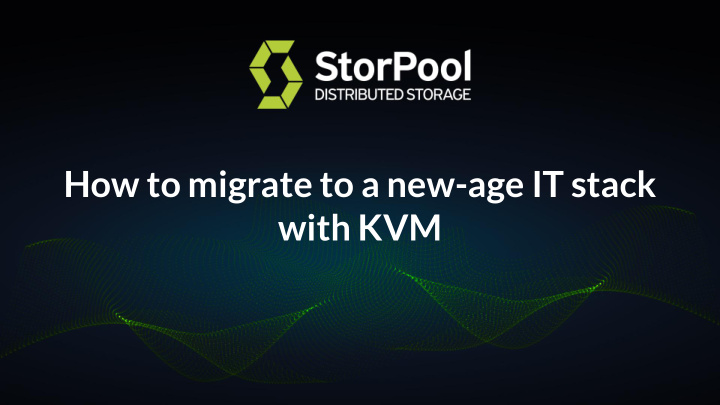



How to migrate to a new-age IT stack with KVM
● Present a method to migrate from traditional hypervisors to KVM ● Optimized process, using only open source tools ● Live demo: Migrate a Windows VM from VMware to KVM ● Q & A
Positives ● Modern "new age" IT stack ● The best for cloud-native applications and cloud platforms (K8S, OpenStack) ● Flexibility, Optimization - do what you need how you need it ● No vendor lock-in ● No vendor license fees Same ● Commercial vendor support, if needed Drawbacks ● Requires Linux know-how ● Less-developed support matrix ● Perhaps too much choice
● Virtual machines configuration ○ vCPU, RAM ○ Virtual Disks ○ NICs ○ Other Virtual Hardware ● Disk images ● Storage settings - QoS, ACL, etc. ● Virtual Networks ○ VLANs, IP addresses, reservations ○ Firewall rules ○ Services - DNS, DHCP, Load balancers, etc. ● Users, access control, … ● Service definitions ● UI, Integration with 3rd party (billing), CI/CD, k8s, ● Other services - e.g. DR, Backup,
● Hypervisor ESXi / vCenter → KVM / OpenNebula ● Storage vmdk image / VMFS / Shared iSCSI → raw image / shared block (StorPool) ● Guest OS - Windows Server 2019 ● Guest drivers: Disk: LSI Logic SAS → virtio-scsi NIC: Intel E1000e → virtio-net
1. Convert VM metadata and define a new VM at the target hypervisor 2. Stop the VM at the source hypervisor 3. Copy the disk images from the source to the target hypervisor 4. Convert the VM disk image format 5. OS morphing - update settings, install drivers for the new emulated hardware, etc. 6. Start the VM at the target hypervisor Source Target Target VM VM VM
1. Define a new VM at the target hypervisor 6. Apply the snapshot on the target image 2. Take a snapshot 7. OS morphing 3. Transfer the image 8. Start the target VM 4. Stop the source VM 5. Transfer the snapshot image Source Target Target VM VM VM
• qemu-img : use the package supplied by the Linux distro • sesparse : Open source tool to read and process vmdk images. https://github.com/storpool/any2kvm • virt-v2v : http://download.libguestfs.org
The Demo Setup
The Demo Setup
1. Define a new VM at the target hypervisor 2. Take a snapshot of the VM disks on the source hypervisor 3. Copy the disk image to the target hypervisor 4. Convert the VM disk image format 5. Stop the VM at the source hypervisor 6. Copy the snapshot image to the target hypervisor 7. Apply the snapshot image to the target image. 8. OS morphing 9. Start the VM at the target hypervisor
● VMWare ● MS Hyper-V ● Citrix XenServer ● Anything that can create snapshots in separate files Tools Available at https://github.com/storpool/any2kvm ● sesparse, vhdx , vhd - tools to read vmdk, vhdx and vhd image formats and apply snapshots. ● Scripts to automate the process ● Patch for virt-v2v for Windows guests
Q&A Thank you!
Download a Step-by-Step Guide: How to Migrate to a New-Age IT Stack with KVM https://storpool.com/how-to-migrate-to-kvm
Venko Moyankov StorPool Storage vm@storpool.com info@storpool.com www.storpool.com @storpool
Recommend
More recommend